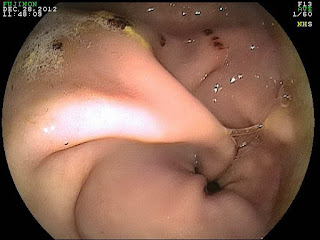The following radiographs are from a gelding that has been lame for nearly 1 year. The gelding has been treated for laminitis/founder and despite efforts by the farrier and veterinarian, the gelding's conditions has worsened. He is non-weight bearing on one forelimb at the time of my exam. The right front foot is imaged in Figure 1 and the left front foot in Figure 2. In Figures 3 and 4 the palmar angle (angle "A") is measured in both front feet. The palmar angle corresponds to the angle that the bottom or palmar surface of the coffin bone makes with the horizon. In both front feet, the palmar angle measures approximate +23-25 degrees. Normally, the palmar angle may range between zero to +5 degrees. Abnormal palmar angles may be negative or greater than +7-8 degrees. However, even though the right and left front feet share the same palmar angle, it is for two very different reasons!
 |
| Figure 1 (Right front) |
 |
| Figure 2 (Left front) |
 |
Figure 3 (Right front)
|
 |
Figure 4 (Right front)
|
The most likely causes for an increased palmar angle include
coffin bone rotation and
coffin joint contracture. The difference between these two conditions is key to making the correct diagnosis. In the case of laminitis, the coffin bone rotates under the influence of the deep digital flexor tendon and due to a lack of attachment between the coffin bone and the lamina (i.e. laminitis). In Figure 5, the degree of coffin bone "rotation" is estimated based on the difference between angles "A" and "B". Normally, the hoof wall (red line over "A") is parallel with the coffin bone (red line over "B"). When these two lines are parallel, the angles equal each other and there is zero degrees of coffin bone rotation. Therefore, the problem with the left front limb in Figure 5 is laminitis and secondary coffin bone rotation.
 |
| Figure 5 (Left front) |
The right front foot has zero degrees of coffin bone rotation however the palmar angle is the same as in the left front foot. This due to
coffin joint contracture and is the definition of a "Club foot". In Figure 6, the lines corresponding to the hoof wall and coffin bone are parallel and as such angle "A" equals angle "B". Figure 7 diagrams the concept of coffin joint contracture that results in an angle of contracture (angle "A"). Typically, a club foot or coffin joint contracture does not result in non-weight bearing lameness but rather a life long commitment to proper shoeing and trimming. In this case, first glance of the radiographs might be deceiving because both front feet have an abnormal palmar angle, but it is the left front foot with the coffin bone rotation and life threatening laminitis! The deep digital flexor tendon was transected in the left front limb and follow-up radiographs will follow!
To be continued......
 |
| Figure 6 (Right front) |
 |
| Figure 7 (Right front) |
















